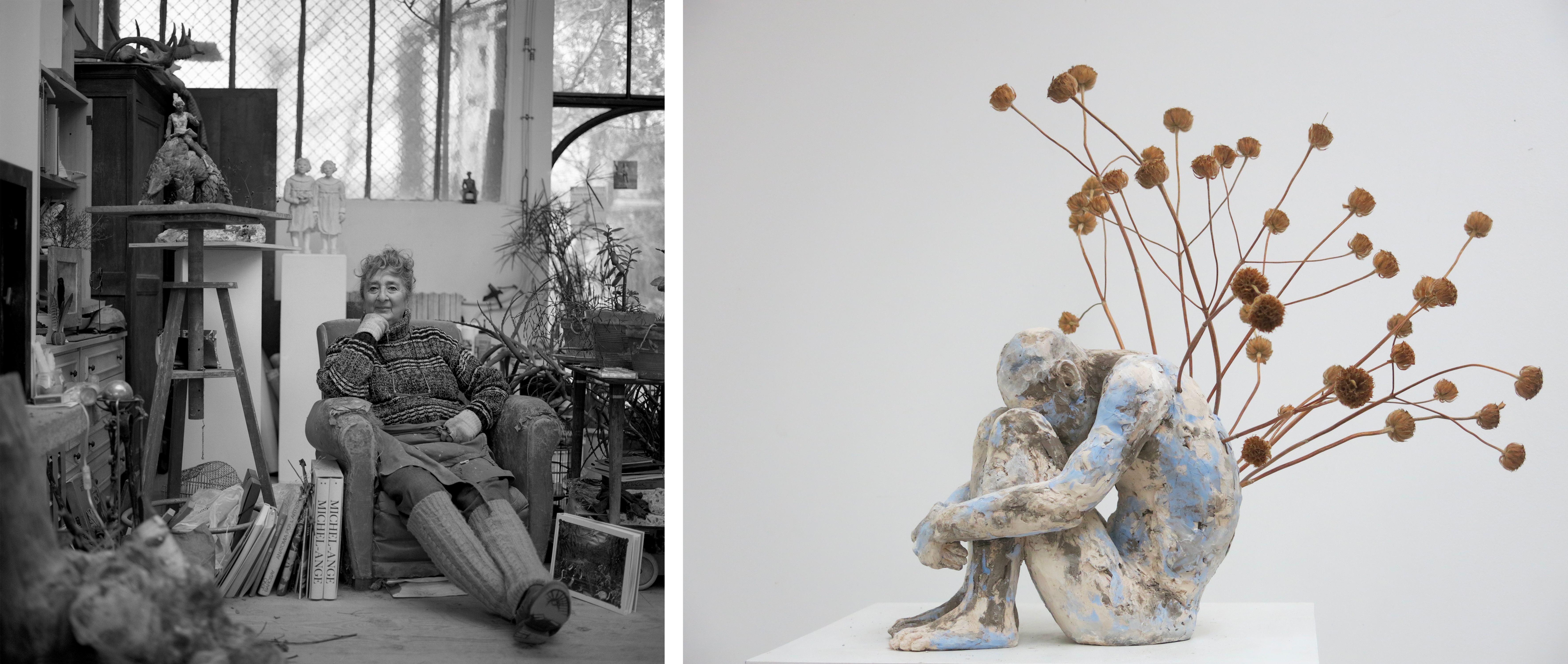
MONICA MARINIELLO SCULPTURE | SCULTURA
Monica Mariniello is a designer and sculptor who lives and works in France where she trained at Beaux Arts in Paris. Sensitive to the themes of ecology, the human-animal relationship, and the nature of relationships among living beings, her artistic research dialogues with the issues that preoccupy our present. The works in the exhibition, terracotta sculptures that arise out of inspiration from the material itself, invite a meditation on the fragile and powerful bonds between human beings and nature.
Born in Siena and raised between Florence and the Maremma, her works, in their themes as in their formal research, preserve the signs and traces of the landscape in which she grew up: “When I was a child, and also later, I spent long afternoons wandering around the Tuscan countryside, often at Etruscan sites,” Monica Mariniello recalls, “the traces of chariot wheels inscribed in the stone of the streets of a city gone forever, the blocks of the outer walls, the tombs full of silence and fresh air, the small rhombuses of white marble running along an open-air amphitheater, all this was carved into my memory as I tried with all my might – eyes closed, crouched close to the ground – to revive the noise, the colors, the voices of a city that had known of dreams of an infinite future, of certainties of a tomorrow identical to yesterday. I come from there and my work also feeds on that.”
Monica Mariniello è una disegnatrice e scultrice che vive e lavora in Francia dove si è formata alle Beaux Arts di Parigi. Sensibile ai temi dell’ecologia, del rapporto uomo-animale, della natura delle relazioni fra gli esseri viventi, la sua ricerca artistica dialoga con i temi che preoccupano il nostro presente. Le opere in mostra, sculture in terracotta che nascono per ispirazione della stessa materia, invitano a una meditazione sui legami fragili e potenti fra esseri umani e natura.
Nata a Siena, cresciuta fra Firenze e la Maremma, i suoi lavori, nei temi come nella ricerca formale, conservano i segni e le tracce del paesaggio in cui è cresciuta: “Quando ero piccola, ed anche in seguito, ho passato lunghi pomeriggi a girare per la campagna toscana, spesso in siti etruschi – ricorda Monica Mariniello – le tracce delle ruote dei carri inscritte nella pietra delle strade di una città sparita per sempre, i blocchi delle mura esterne, le tombe piene di silenzio e di aria fresca, i piccoli rombi di marmo bianco che corrono lungo un anfiteatro a cielo aperto, tutto questo si è scolpito nella mia memoria, mentre provavo con tutte le mie forze – gli occhi chiusi, accovacciata vicino al suolo – a far rivivere il rumore, i colori, le voci di una città che aveva conosciuto dei sogni di un futuro infinito, delle certezze di un domani identico a ieri. Io vengo di là ed il mio lavoro si nutre anche di questo”.
“The nature-culture nexus is a crucial anthropological issue. Renamed in theoretical jargon as the relationship between humans and nonhumans or between their respective ontologies, this issue has punctuated the history of thought through a play of oppositions and alignments, between those who have defined human civilization as a progressive distancing from the natural state and those who have argued for the need to maintain a relationship with the condition of nature, or the wild state. Today, also in relation to post-colonial or decolonial thought, anthropology is returning to these themes by renewing its attention to the worldview of those cultures that would once have been called “animist” and that suggest the possibility of a nature-culture continuum or the real and literal existence of different and parallel worlds, of plural ontologies. An ontological turn that at least since the 1990s has been moving by trying to dismantle the dichotomies on which our imaginary is built, in search of a new regime of sociability among species. A debate that in Monica Mariniello’s works resonates as an aspiration, a desire, an act of will moved by concern for the fate of the planet.”
“Il nesso natura – cultura è una tematica antropologica cruciale. Rinominata nel gergo teorico come rapporto fra umani e non umani o fra le rispettive ontologie, questa tematica ha punteggiato la storia del pensiero attraverso un gioco di contrapposizioni e allineamenti, tra chi ha definito la civiltà umana come progressivo distanziamento dallo stato naturale e chi ha sostenuto la necessità di mantenere un rapporto con la condizione di natura, o con lo stato selvaggio. Oggi, anche in relazione al pensiero post-coloniale o decoloniale, l’antropologia torna su questi temi rinnovando la propria attenzione verso la visione del mondo di quelle culture che un tempo si sarebbero chiamate “animiste” e che suggeriscono la possibilità di un continuum natura-cultura o la reale e letterale esistenza di mondi differenti e paralleli, di ontologie plurali. Una svolta ontologica che almeno dagli anni Novanta si muove cercando di smontare le dicotomie su cui è costruito il nostro immaginario, alla ricerca di un nuovo regime di sociabilità fra le specie. Un dibattito che nei lavori di Monica Mariniello risuona come un’aspirazione, un desiderio, un atto di volontà mosso dalla preoccupazione per le sorti del pianeta.”
– Sandra Burchi
For details about artist and available artworks send us a request:





